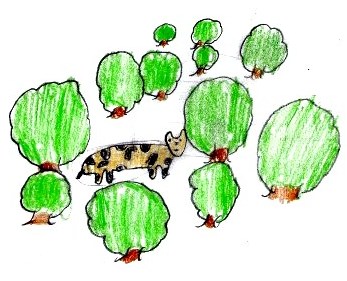KODKOD
KODKOD - Forecasting conservation needs for endangered fauna: integrating landscape ecology and ethnoecology to predict habitat quality for the kodkod cat (Leopardus guigna) in the Chilean temperate rainforest

Coordination: Dr. Klaus Henle
Principle investigator: Dr. Elke Schüttler
Research: Dr. Elke Schüttler , Dr. Reinhard Klenke
Project partners: Dr. Cristián Bonacic (Pontifica Universidad Católica de Chile, Fauna Australis Wildlife Laboratory)
, Dr. Thora Herrmann (Institute of Geography, Université de Montréal, Canada)
Funded by: Seventh Framework Programme (FP7), Marie Curie International Outgoing Fellowships (FP7-PEOPLE-2009-IOF, contract number POIF-GA-2009-252682)
Project duration: 31.05.2010 - 22.11.2014
Project description
Wild cats, which generally require large areas over which to forage, are particularly affected by fragmentation and human-felid conflicts. Whereas considerable research has been directed towards large carnivores, smaller more cryptic species have received comparatively little attention. The kodkod cat or guiña (Leopardus guigna) is the smallest of the Neotropical cats and has one of the most restricted distributions known for felids, occupying a narrow strip within south-central Chile and Argentina. Kodkods are classified as vulnerable by IUCN. Principal threats are habitat loss due to agricultural land use and retribution killing after attacks on poultry. The general aim of the project is to establish an integrative socio-ecological approach for kodkod conservation. It aims to explore the current habitat availability for this threatened species in forest remnants of private landowners in the foothills of the Andes in the Araucania Region in southern Chile.
An autecological study is using radio-telemetry for the first time in the northern pre-Andean distribution range to assess habitat use, home ranges and activity patterns. Through systematic monitoring with camera-traps the effects of fragmentation, infrastructure and land uses on the probability of site occupancy are being analyzed. A socio-ecological study provides understanding of the human environment context in which this wild cat lives. Qualitative interviews and a representative questionnaire survey with landowners and indigenous Mapuche people explore knowledge, attitudes, tolerance levels and cultural significance of kodkods. The future stakeholders’ perceptions are assessed through school visits during which drawings of the kodkod cat are received as well as through legends and local anecdotes collected as homework in the children’s family context.
The research results can contribute to derive specific environmental education strategies that positively influence the younger generation’s position towards the kodkod cat. A puppet video relating life and problems from the perspective of the kodkod cat Leopolda has already been created for distribution at local schools and via the internet. For the final socio-ecological project integration, future land use scenarios will be modelled. This allows strategies to be identified for mitigating conflicts between the development process and habitat quality through Conservation Round Tables with the region’s stakeholders, while at the same time general conclusions for conservation strategies of conflictive elusive carnivores in fragile ecosystems can be derived.
Publications
https://doi.org/10.1111/1365-2664.13072
https://doi.org/10.1016/j.mambio.2016.11.013
Links of cooperation partners:
Department of Ecosystems and the Environment, Pontificia Universidad Católica de Chile
Fauna Australis Wildlife Laboratory, Santiago de Chile
Fauna Australis field station, Pucón, Chile
Institute of Geography, Université de Montréal, Canada

